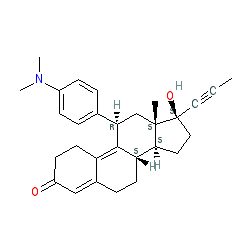GtoPdb is requesting financial support from commercial users. Please see our sustainability page for more information.
|
Synonyms: Mifeprex® | RU-486 | RU486
mifepristone is an approved drug (FDA (2000))
Compound class:
Synthetic organic
Comment: An antagonist of both the glucocorticoid receptor and the progesterone receptor.
Ligand Activity Visualisation ChartsThese are box plot that provide a unique visualisation, summarising all the activity data for a ligand taken from ChEMBL and GtoPdb across multiple targets and species. Click on a plot to see the median, interquartile range, low and high data points. A value of zero indicates that no data are available. A separate chart is created for each target, and where possible the algorithm tries to merge ChEMBL and GtoPdb targets by matching them on name and UniProt accession, for each available species. However, please note that inconsistency in naming of targets may lead to data for the same target being reported across multiple charts. ✖
View more information in the IUPHAR Pharmacology Education Project: mifepristone |
|
|||||||||||||||||||||||||||||||||||
| References |
|
1. Heikinheimo O, Kontula K, Croxatto H, Spitz I, Luukkainen T, Lähteenmäki P. (1987)
Plasma concentrations and receptor binding of RU 486 and its metabolites in humans. J Steroid Biochem, 26 (2): 279-84. [PMID:3560943] |
|
2. Lehmann JM, McKee DD, Watson MA, Willson TM, Moore JT, Kliewer SA. (1998)
The human orphan nuclear receptor PXR is activated by compounds that regulate CYP3A4 gene expression and cause drug interactions. J Clin Invest, 102 (5): 1016-23. [PMID:9727070] |
|
3. Rupprecht R, Reul JM, van Steensel B, Spengler D, Söder M, Berning B, Holsboer F, Damm K. (1993)
Pharmacological and functional characterization of human mineralocorticoid and glucocorticoid receptor ligands. Eur J Pharmacol, 247 (2): 145-54. [PMID:8282004] |
|
4. von Geldern TW, Tu N, Kym PR, Link JT, Jae HS, Lai C, Apelqvist T, Rhonnstad P, Hagberg L, Koehler K et al.. (2004)
Liver-selective glucocorticoid antagonists: a novel treatment for type 2 diabetes. J Med Chem, 47 (17): 4213-30. [PMID:15293993] |
|
5. Zhi L, Tegley CM, Pio B, Edwards JP, Jones TK, Marschke KB, Mais DE, Risek B, Schrader WT. (2003)
Synthesis and biological activity of 5-methylidene 1,2-dihydrochromeno[3,4-f]quinoline derivatives as progesterone receptor modulators. Bioorg Med Chem Lett, 13 (12): 2071-4. [PMID:12781197] |








